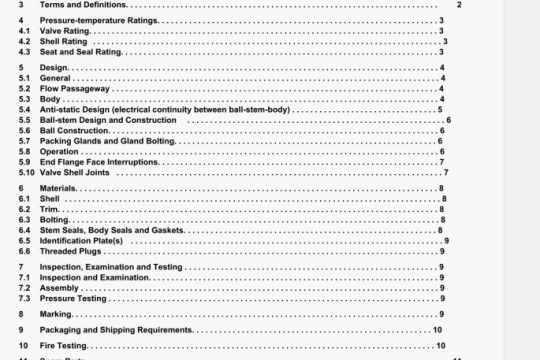API Spec 12K:2008 pdf download
API Spec 12K:2008 pdf download.Specification for Indirect Type Oilfield Heaters.
3.4
coils
Aiso referred to as a tube bundle, the device through which fluid to be heated Is passed.
NOTE One or more coals which may be typically arranged as a angle pass cod, spit pass coil, or spiel coil. dlusfrated in Figure 2. The single pass cod is normally a serpentine pattern with only one flow path. This cod may also be arranged to provloe two or more parallel flow paths for reduced pressure drop, but as still referred to as a swagle pass cod. The sØt pass cod may be designed for Iwo pressure ratings, allowing for a choke to be located between the two coil sections Split pass cods are used when it as necessary to use two heating stages to nwiimize hydrate formation within the coiL The spiral cod Is generally used on smaller heaters and Is normally a single pass coil. f&Itaple coils may be used W more than one wed streeni is processed In the same heater shed.
3.5
fill connection
Connection on the top of the shell provided with a pressure-vacuum venting device.
NOTE It a water saver is furnished, the f and vent connection may be Integral with It.
3.6
firebox
Complete assembly consisting of the firetube, mounting flange, intake and stack adaptors.
3.7
firetube
Consisting of one or more U-tubes fired, normally by natural gas, at one end and exhausting through a vertical stack.
NOTE hi larger heaters, the betube may consist cia large diameter first pass firelube and multiple rattan tubes manitolded into a common stack. The firetube that portion of the firetiox in contact with the healer bath.
3.8
fusion
Melting together of filler material and base material, or of base material only, which results in coalescence.
3.9
heat density
Heat released through the cross section of the firetube, expressed as BTUIhrhn2 of cross sectional area.
3.10
heat flux
Applied to the average transfer rate through the firetube. expressed as BTUi’hr/ft2 of exposed area.
3.11
heater bath
Indirect heating medium. lwnited to water or water solutions.
NOTE When freezing is possible. eth,iene glytol may be added for anti-freeze protection. Other additives to the water bath may include corrosion inhItors.
3.12
intake flame arrestor
Device placed on the aw intake of the firetube to prevent propagation of flame from inside the firelube to the outside atmosphere, consisting of a corrugated aluminum cell mounted in a metal housing which attaches to the lirebox.
3.13
linear Indication
Closed surface area martung or denoting a discontinuity requiring evaluation, whose longest dimension is at least ttwee times the width of the indication.
3.14
removable
Total component is fleld replaceable without welder assistance.
3.15
rounded Indication
Closed surface area marking or denoting a disconirnuity requiring evaluation, whose longest dimension is at least three times the width of the indication.
3.16
shell
Normally a horizontal vessel which contains the coil, firetube and heater bath.
3.17
slag inclusion
Nonmetallic solid material entrapped Wi weld metal or between weld metal and base metal
3.18
spark arrestor
Device placed on the exhaust of the stack to prevent sparks from being emitted to the outside atmosphere, consisting of a metallic Anre screen attached across the top diameter of the stack.
3.19
stack downdraft diverter
Device attached to the top of the stack designed to reduce the effects of wind currents on the burner system.
3.20
stack flame arrestor
Device placed on the exhaust of the stack to prevent propagation of flame from inside the firehibe to the outside atmosphere, normally consisting of a corrugated aluminum or stainless steel cell mounted in a metal housing which attaches to the top of the stack.
3.21
stack rain shield
Device attached to the top of the stack to prevent rain from falling ds’ectly Into the stack. It may also serve as a stack downdraft diverter,
3.22
undercut
Groove melted into the basic material adjacent to the toe or root of a weld and left unfilled by weld material.
3.23
water saver
Chamber that may be directly connected to the heater shell to permit the shell to be completely filled with water.
NOTE The water m this chamber exista at a lower temperature than the heater bath which reduces evoratIcn losses. It may also be referred to as wi economizer or expansion tank, Its capacity should be sufficient to contain the water expansion between ambient arid operating temperatures.




